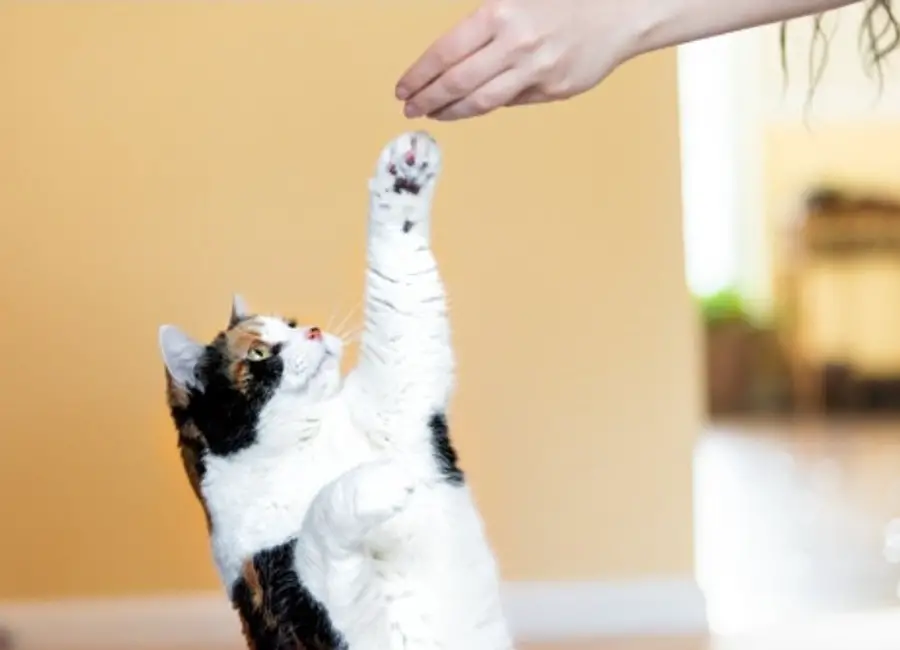Ways To Discipline a Cat The Right Way

This post will address some common ways to discipline a cat, so keep reading to find out more…
As cat owners, we all know that cats can be quite mischievous at times and need to be disciplined.
Unfortunately, some cat owners turn to harsh methods of discipline, which can cause further behavioral issues.
Thankfully, there are many effective ways to discipline cats without causing them harm or distress.
Tips On Ways To Discipline a Cat
Here are the most common ways to discipline a cat the right way:
- Limit the cat’s access to favorite areas: Cats love to explore and get into trouble, so limit access to areas of your home where they can get into trouble by using fences or gates.
- Redirect bad behavior immediately: Redirection is one of the most effective ways to discipline a cat. When your kitty starts misbehaving, distract them with a toy or another activity. This will help them learn to associate the action with something positive and will discourage them from repeating the negative behavior.
- Give your cat timeout in the act: Timeouts are a great way to discipline cats since they can’t understand verbal cues. Place your cat in a separate room for a few minutes, and they’ll quickly learn that the behavior is unacceptable.
- Speak to your cat firmly: Let your cat know that their behavior is unacceptable by speaking in a firm, but not angry, voice.
- Always use positive reinforcement: Positive reinforcement is a great way to teach cats good behavior. Whenever your kitty does something good, reward them with a treat or a bit of attention. This will help them understand that the behavior is desirable.
- Use squirt bottles when necessary: This method is controversial but can be effective when used in moderation. When your cat misbehaves, squirt them with a bottle of water. This will startle them and teach them that the behavior is unacceptable.
- Use verbal cues: Cats can learn verbal commands if they use them consistently. Whenever your kitty misbehaves, tell them “No” in a firm voice. This will help them learn what is acceptable and what isn’t.
- Use clickers when needed: Clicker training is a great way to train cats. Whenever they perform the desired behavior, click the clicker and reward them with a treat. This will help them understand that the behavior is desirable.
- Make use of catnip: Catnip can be a great way to redirect cats from negative behavior. Sprinkle a bit of catnip on an area that your cat shouldn’t enter and they’ll stay away from the area.
- Scold when necessary: Scolding your cat can be effective if you use it correctly. When your kitty misbehaves, tell them “No” in a stern voice. This will help them understand that the behavior is unacceptable.
- Use deterrents when necessary: Spraying a deterrent such as lemon juice in areas your kitty shouldn’t enter can be a great way to keep them away. Just make sure you don’t spray it directly on your cat.
- Always praise good behavior: Make an effort to praise your cat when they do something good so that they understand what behavior you want from them.
- Be consistent with commands: Cats learn quickly, but they need consistency to really understand what is acceptable and what isn’t. Make sure that you’re consistent in your discipline and use the same methods each time.
- Avoid punishment: Punishment isn’t an effective way to discipline cats as it does not teach them what behavior is acceptable.
- Consistently reward good behavior: Rewarding your cat with treats or a special toy after they have done something good is an effective way to get them to do it again.
When is it time to discipline a cat?
There is no definitive answer to this question since it depends on the cat’s personality and behavior.
However, some general tips to follow when disciplining a cat include:
If the cat is being destructive or causing trouble in the home, start by talking to the cat in a calm and gentle voice.
When the cat does not respond, try gently scooping them up and taking them outside.
If the cat is being aggressive or defensive towards you, other family members, or other pets.
Cat behaviors that need to be disciplined
Here are some common cat behavior concerns you should discipline your cat of:
- scratching furniture or walls
- Jumping up at people
- Being territorial
- Spraying urine or feces
- Climbing up things
- Being uncooperative
- Not using the litter box
- Being destructive
- Being unusually vocal or aggressive
Ways not to discipline a cat
Here are some things to avoid when disciplining your cat:
- Ignoring the cat. This will only make the cat more determined to get your attention.
- Yelling at the cat. This will only make the cat more determined to get your attention.
- Ignite a fire in the cat’s room. This will only make the cat more determined to get your attention.
- Throw a brick at the cat. This will only make the cat more determined to get your attention.
- Put the cat in a cage. This will only make the cat more determined to get your attention.
- Force feed the cat. This will only make the cat more determined to get your attention.
- Not feeding your cat at all.
- Beating up your cat.
- Rubbing your cat’s mouth on his poop or urine.
Side effects of not disciplining a cat
If your cat is not being disciplined, it may be doing things like scratching furniture, spraying urine, or making too much noise.
These are all signs that your cat needs some discipline and a healthy fear of humans.
Keep in mind that punishing your cat beyond what it can take can force them to disappear without a trace.
Conclusion
By using these methods, you can effectively discipline your cat and teach them what is acceptable behavior.
Remember, cats are smart, and they need to be given boundaries.
If you’re consistent in your discipline and use positive reinforcement, your cat will learn quickly.
Disciplining cats can be a challenging task, but if done right, it can help create a bond between the two of you and ensure that your feline friend is well-behaved.
Give these tips a try the next time your cat misbehaves and you’ll be sure to have a happy, well-behaved kitty in no time.
Read more: 9 Most Common Traumatized Cat Symptoms.
